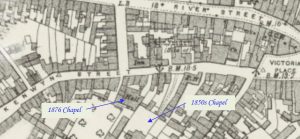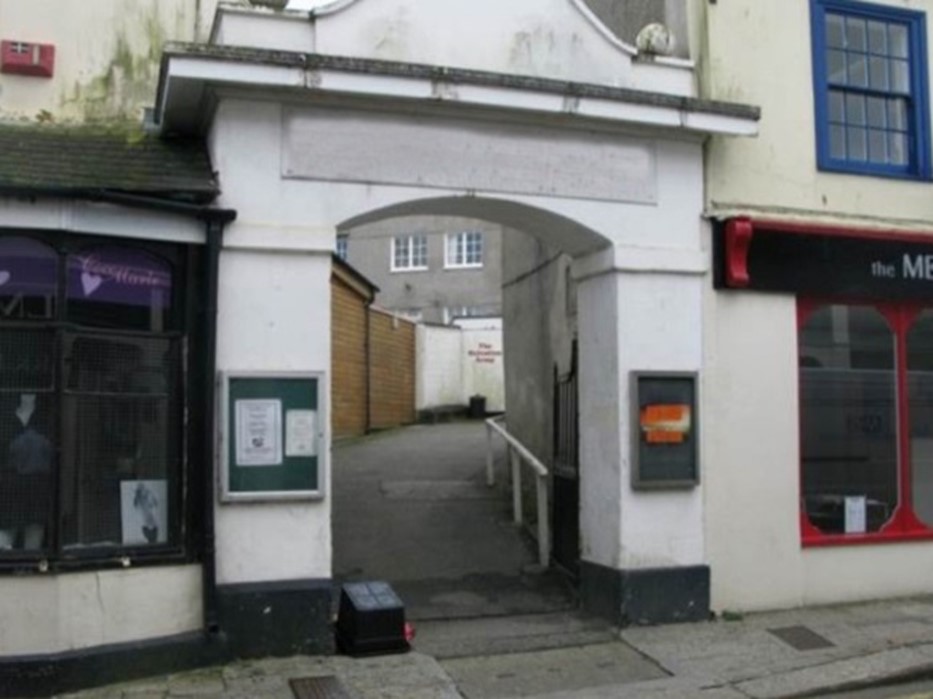Mapping Methodism – Truro Wesleyan Reform / United Methodist Free Church
Categories Mapping Methodism1 Comment

This profile of Truro Wesleyan Reformers / United Methodist Free Church has been compiled by Tony Mansell.
Wesleyan Reformers founded following a split from the Wesleyan Methodist Church.
The UMFC came to the town in 1850 in the form of the Wesleyan Reformers. (A Dictionary of Methodism)
1849: The leaders of the Wesleyan Reformers were expelled from the Wesleyan Methodist Church at its Manchester Conference. (Wikipedia)
March 1850: 400 delegates met at the Albion Chapel, Moorfields, London to establish a new connexion.
It seems that the was a desire for an autonomous form of government with each church administering its own affairs. Reform societies sprang up in Camborne, Redruth, Truro, St Austell & St Columb (Union)
1849 Meeting Place
1849: Truro Wesleyan Reformers thought to have first met in house in Union Place.
1850 Chapel
Circa 1850: Truro Wesleyan Reformers built a chapel in Ferris Town. (A Dictionary of Methodism)
Society was soon faced with financial problems and had to sell their chapel. (A Dictionary of Methodism)
1857: The church dissolved when most of the members amalgamated with the Wesleyan Association to form the United Methodist Free Churches, which later became the United Methodist Free Church.
1857: The Wesleyan Methodist Association and the Wesleyan Reform Church amalgamated to become the United Methodist Free Churches
1857: The only Cornish Wesleyan Reformers circuit represented at the first UMFC annual assembly in 1857. (A Dictionary of Methodism)
Circa 1959: The remaining members of the Wesleyan Reform Church formed the Wesleyan Reform Union.
1850s Chapel
Meeting in the Baptist church. (A Dictionary of Methodism)
Mid-1850s to 1876: Chapel in Kenwyn Street (Through William IV’s beer garden). It had previously been used by the Congregationalists / Presbyterians and Baptists.
1860s: The society was joined by the local Teetotal MethodistSsociety, again a break-away from the Wesleyans. (A Dictionary of Methodism)
1876 Chapel
1876: The society moved to the Kenwyn Street chapel earlier vacated by the Wesleyans and out of religious use for some years. (A Dictionary of Methodism)
1875/76: Rev. J Cockin appointed minister and remained in post for 37 years.
 The Kenwyn Street Chapel
The Kenwyn Street Chapel
1876 to 1881: The chapel in Kenwyn Street which had been used previously by the Wesleyans 1796-1830), the Wesleyan Reform Church & Union (1852-1857), and prior to 1976, as a music hall and a school. It would later become the home of the Oddfellows Friendly Society and the Salvation Army (1882 to present – 2020).
“… a short time ago the idea was formed of building a new chapel, in consequence of the old one being insufficient to meet the requirements of a largely-increasing congregation…” (Royal Cornwall Gazette – Friday 12 March 1880)
1880 Chapel
United Reform Methodist Church is now in educational use. Dressed stone brought to course, good freestone dressings. Good Gothic style unaltered example. Ornate 1:3:1-bay show front has central traceried window; elaborate piers flanking central bays rising above as truncated spirelets; also rose windows to returns of side bays. Good interior with horse-shoe gallery and original fittings. Part of a good group of historic buildings in this part of Truro. (Cornwall Heritage Gateway)
A piece of ground at a cost of £150 was secured in St. George’s Road. (Royal Cornwall Gazette – Friday 12 March 1880)
“The Plans of Mr James Hicks of Redruth, were accepted and a short time ago Mr James Blight’s (Redruth) tender for the erection of the building at £2,245, was agreed upon. Mr W. H. Bray builder, of Truro, was appointed clerk of the works… The building will comprise a school, capable of holding about 500 children, vestries, and the chapel above, the interior of which will be seated in amphitheatre style with side seats slightly sloping. There will be a large gallery which, with an orchestra, will encircle the building, supported by iron pillars, and with ornamental iron panelling. A rostrum will extend from the orchestra with similar panelling, to be made of pitch pine, as will also the pews. They are to be of modern character with open ends. The seating accommodation will be for about 600. The building will be plaster waggon-roofed, with a few carved cross-beams protruding. The whole of the building will be heated with patent gas stoves. MacFarlane’s ornamental railings, giving a very neat and pretty appearance will fringe the south boundary wall which faces St George’s Road. The chapel is expected to be opened for worship next Christmas.” (Royal Cornwall Gazette – Friday 12 March 1880)
1880: “The ceremony of laying the foundation stones took pace in favourable weather on Friday afternoon, some hundreds of people gathering on the spot long before the appointed hour: and the ceremony was also viewed from the leats at the rear of a large concourse. A procession was formed in the schoolroom of the old building in Kenwyn Street, the Sunday-scholars and teachers, choir and office-bearers, and some scores of visitors from Camborne and elsewhere joining, headed by the pastor and other ministers of the city, marched to the marched to the site of the new edifice…” (Royal Cornwall Gazette – Friday 12 March 1880)
1880 – October: Construction of chapel complete.
Built as a United Methodist Free Church. (SWChurches)
Part of Truro United Methodist Free Church Circuit. (SWChurches)
“The building of the new chapel was started by Mr Blight who was unable to complete the work or pay his workmen. The work was then continued by Mr Gray of Redruth “whose conduct of his contract was most satisfactory to everybody concerned”. (Royal Cornwall Gazette 2 December 1881)
 1881 – St George’s United Methodist Free Church – designed by Walter Chalmers Smith
1881 – St George’s United Methodist Free Church – designed by Walter Chalmers Smith
1881: “The handsome new chapel which the United Methodist Free Church have built in St. George’s Road, Truro, was opened for divine worship yesterday (Thursday)…” (Royal Cornwall Gazette 18 February 1881)
1881: “On Friday evening, in the presence of a crowded congregation, the new organ was erected in St. George’s Chapel, Truro, by Messrs. Brewer & Co., was formally opened by Mr. Edmond Holt, who gave a recital on the occasion…” (Royal Cornwall Gazette – Friday 30 September 1881)
22 Feb 1882: Certificate of registration, marriages, St George’s United Methodist Free Church, Truro. (Kresen Kernow MRT/1407)
Jan 1896: Papers, renovation of organ, St George’s United Methodist Free Church, Truro. Memorandum, specification and estimate. (Kresen Kernow MRT/211)
1896: “Truro. St. George’s U.M.F.C. Chapel, Truro, was filled on Friday evening, when the organ was reopened after considerable enlargement…” (Cornubian and Redruth Times – Friday 06 November 1896)
Circa 1900: List of chapel keeper’s duties, St George’s United Methodist Free Church, Truro. (Kresen Kernow MRT/212)
1903: Lecture hall and vestry added.
1907: The Methodist New Connexion, Bible Christians and United Methodist Free Churches amalgamated to become the United Methodist Church.
1907: Became St George’s United Methodist Church. (SWChurches)
Part of the Truro United Methodist Circuit. (SWChurches)
1932: The Wesleyan, Primitive Methodist and the United Methodist Church amalgamated to become the Methodist Church of Great Britain.
1932: Became St George’s Methodist Church. (SWChurches)
1940: Seating for 435. (David Easton, Methodist Minister and historian)
Mid-20th century: Plan of church, St George’s Methodist Church, Truro. Ground plan of Sunday School, church and gallery. (Kresen Kernow MRT/216)
20th century: Photograph of exterior, St George’s United Methodist Church, Truro. Taken before the pinnacles were removed. (Kresen Kernow MRT/214)
Feb-Nov 1967: Diary of renovations, St George’s Methodist Church, Truro. Includes accounts. (Kresen Kernow MRT/1031)
1970s: Notes, history of Methodism in Truro. Notes on St George’s and St Clement Street Methodist Churches and Methodism in Truro. (Kresen Kernow MRT/217)
Sep 1975: Programme, re-opening of organ, St George’s Methodist Church, Truro. Celebrates re-opening of the organ after renovation work and also new lighting system in church. Contains historical notes. (Kresen Kernow MRT/215)
Aug 1980: Certificate of authorization for registering marriages, St George’s Methodist Church, Truro. Certificate authorising the Reverend Dorothy Moyle to register marriages conducted at St George’s Methodist Church. (Kresen Kernow MRT/1362)
1981: Centenary brochure, St George’s Methodist Church, Truro. Illustrated brochure with history of chapel, founded in 1881. (Kresen Kernow MRT/1032)
1996: The chapel closed. (SWChurches / David Easton, Methodist Minister and historian)
9 Feb 1996: Visual structural survey report, St George’s Methodist Church, Truro. Detailed internal and external structural survey, carried out by Keith Spurgin of The Kirk Spurgin Partnership, chartered surveyors, Redruth. (Kresen Kernow MRT/1363)
The congregation amalgamated with that of St Mary-Clement Methodist Church, Union Place, Truro. (SWChurches)
“… after it was closed and I think in the 90s, before it was sold, I’m sure that there was a period in which the lower rooms were used as a night shelter for street sleepers funded by some charity which withdrew its funding about 2000.” (Alan Murton of Goonhavern and formerly of Truro)
Sep 2006: ‘St George’s. The Story of a Truro Chapel’. Brief history of St George’s Methodist Church, St George’s Road, Truro, originally St George’s United Methodist Free Church. Written by Ron Tonkin. Includes reminiscences by members of the congregation. (Kresen Kernow MRT/1534)
2007: Premises used as St Michael’s Small School. (SWChurches / David Easton, Methodist Minister and historian)
Kresen Kernow holds a series of St George’s Chapel Newsletters.

We live in St George’s Chapel, now named Rosecourt and feel it’s been a very sympathetic restoration. We enjoy being here surrounded by history.
It would be good to have any more information and photographs of our lovely building.
We’re sorry there won’t be a St Piran march from outside the building this year
Thank you